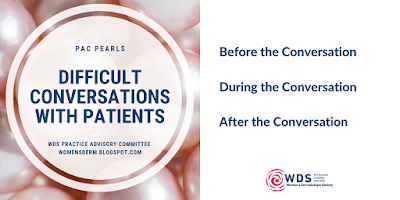Difficult Conversations with Patients #PACPearls
PAC Pearls from the Women’s Dermatologic Society
Follow these tips from the WDS Practice Advisory Committee (PAC) for all stages of having difficult conversations with patients.
Before the Conversation
Successfully addressing an unhappy or concerned patient requires training and preparation. Approach difficult conversations with a customer service mindset using a method called BLAST – Believe, Listen, Apologize, Satisfy, Thank.Detailed by Albert Barneto and further expounded upon for clinicians by Dr. Howard K. Steinman, the BLAST method is a standardized customer based conflict resolution method. By incorporating the BLAST method into staff training, you will be better prepared to have difficult conversations with patients.
During the Conversation
Believe: Believe in the genuineness of the patient's concern and the emotion attached to it.Listen: Maintain eye contact and actively listen without judgement to determine the patient’s concerns. Avoid escalating the emotions of the situation as you can always pause for 5 seconds or reconvene at a later time.
Apologize: Empathize and validate the emotions of the patient. Apologize for the patient’s unmet expectations and offer more context to the issue by restating the patient’s own words.
Satisfy: Offer a resolution to the patient if you are able, but make sure to also address any expectations that you cannot reasonably meet.
Thank: Thank the patient for expressing their concerns and providing an opportunity to offer assistance.
After the Conversation
Patients may not absorb all the information you are telling them particularly if you are delivering bad news. Providing them with appropriate contact information will allow them to ask you, or your staff, questions in their own time.Also keep in mind that despite you’re telling them not to, your patients are going to look up their disease or condition on the internet. That being the case, try and give them information, or sources, that you know will be more informative, and less dramatic.
More Information: Steinman HK. A method for working with displeased patients-blast. J Clin Aesthet Dermatol. 2013;6(3):25–28.
The Women’s Dermatologic Society (WDS) Practice Advisory Committee supports WDS members at any stage of their career looking to manage or start their own practice by offering resources on navigating the practice environment.



Comments
Post a Comment